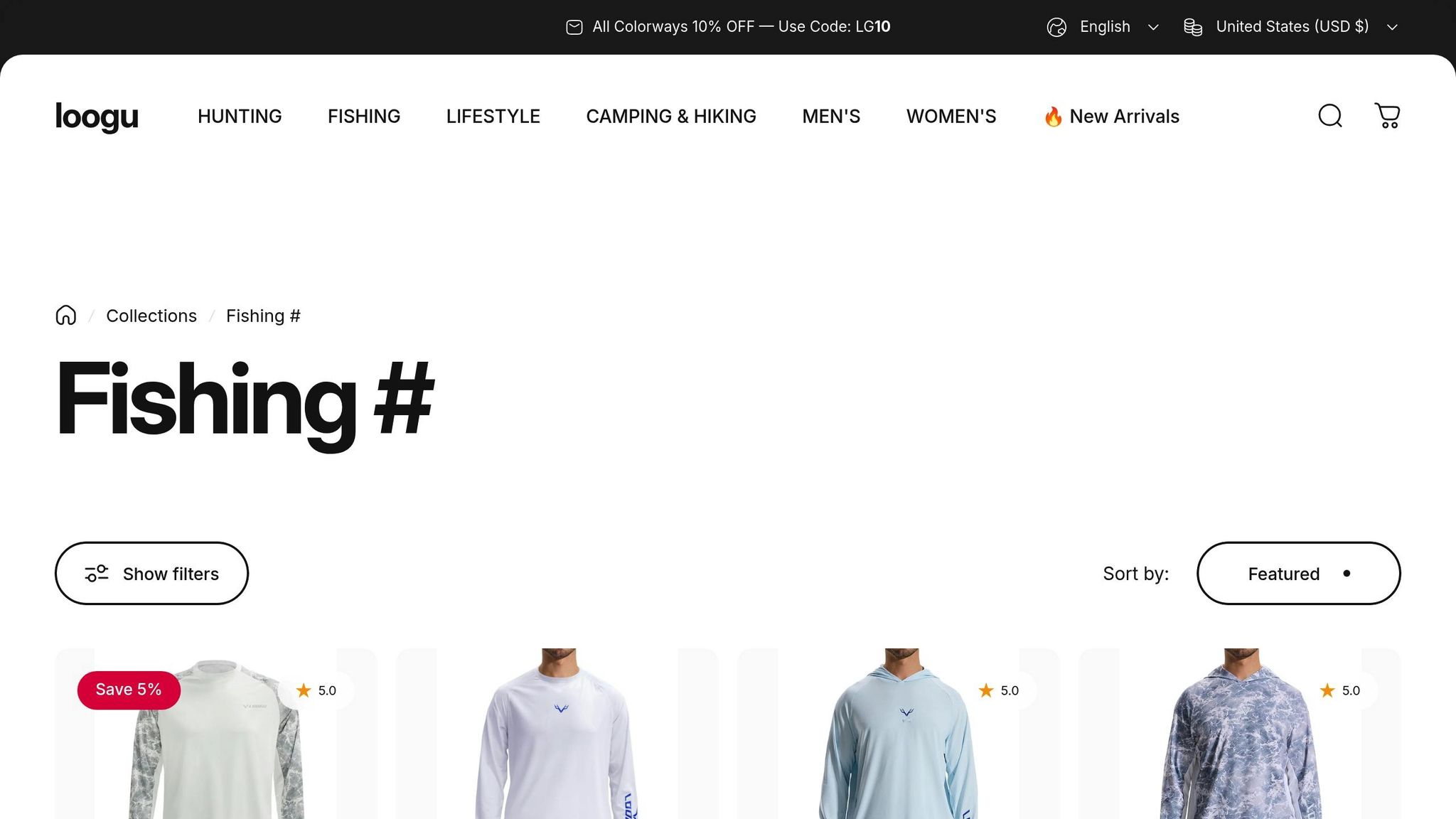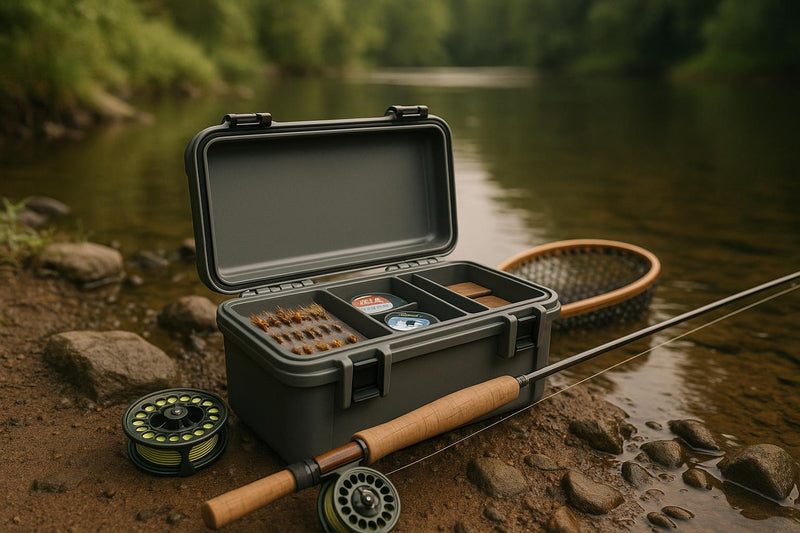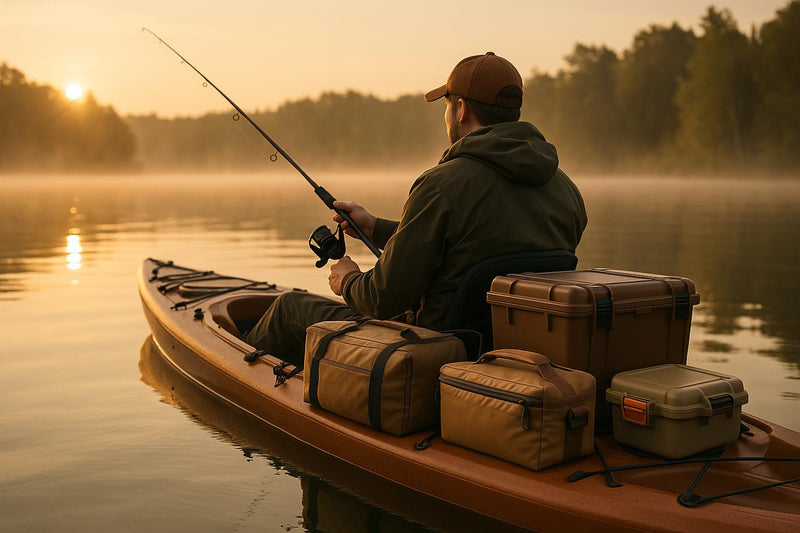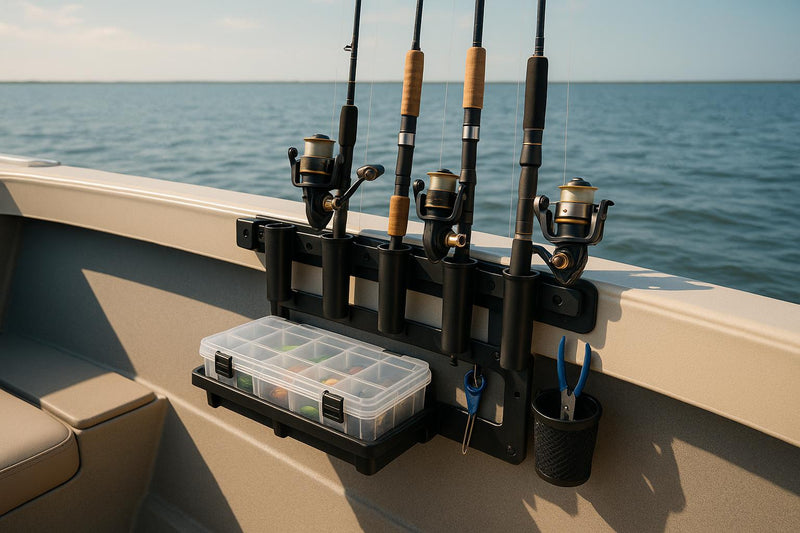Fishing gear takes a beating - sharp hooks, abrasive surfaces, and constant motion can wear it down fast. Choosing the right tear-resistant fabric makes all the difference in durability and comfort. Here’s a breakdown of the top options:
- Ripstop Nylon: Lightweight, flexible, and strong. Great for packable rain gear but less resistant to UV rays.
- Ripstop Polyester: Offers UV protection and color retention. Slightly heavier but ideal for sun-exposed gear.
- Marine-Grade Vinyl: Heavy-duty, waterproof, and abrasion-resistant. Best for covers and storage, not clothing.
Quick Comparison
| Feature | Ripstop Nylon | Ripstop Polyester | Marine-Grade Vinyl |
|---|---|---|---|
| Weight | Lightweight | Slightly heavier | Heavy |
| Flexibility | High | Moderate | Low |
| UV Resistance | Limited | Strong | Moderate |
| Water Resistance | Treated for water resistance | Treated for water resistance | Fully waterproof |
| Tear Strength | High | High | Very High |
| Best Use | Lightweight gear | Sun-exposed gear | Covers and storage |
Each fabric has strengths tailored to specific fishing needs. Prioritize flexibility for mobility, UV protection for sunny conditions, or waterproofing for harsh environments.
A Proven Strategy for Fishing Clothes in 2025 - Tough, Breathable and Quick Drying LOOGU Options

1. Ripstop Nylon
Ripstop nylon has earned its place as a go-to fabric for fishing gear, thanks to its durability and clever design. Originally created for military parachutes during World War II, this material has since become a staple in outdoor and fishing equipment.
Tear Resistance
One of ripstop nylon's standout features is its grid-like weave. By interlocking nylon fibers with thicker threads, the fabric effectively stops small tears from spreading. This makes it a dependable choice for gear that needs to endure tough conditions.
Abrasion Resistance
Ripstop nylon's high tensile strength and resistance to abrasion make it a long-lasting option for fishing gear. It can handle friction and wear, ensuring your equipment lasts longer. Check out our durable Fishing shorts and Mens Fishing Shorts for examples of how this fabric performs.
"Ripstop fabric stands out among other fabrics because of its strength and durability." - Donovan Mathews, Bryden Apparel
Water Resistance
While ripstop nylon isn't naturally waterproof, it can be treated with coatings like silicone, wax, or polyurethane to improve its water resistance. This flexibility allows manufacturers to tailor the fabric to meet the moisture challenges anglers face. For more insights, check out how water-resistant gear protects anglers. The combination of water resistance and durability makes ripstop nylon a reliable choice for fishing environments.
Comfort and Flexibility
Despite its rugged construction, ripstop nylon is lightweight and flexible, making it comfortable for all-day wear. It strikes the perfect balance between strength and mobility, a feature that active anglers value. Plus, it provides excellent ventilation, keeping you cool during long hours on the water.
2. Ripstop Polyester
Ripstop polyester stands out in fishing gear for its impressive UV protection and ability to retain color, making it a great choice for outdoor use under intense sunlight and challenging conditions. This synthetic fabric incorporates a reinforced grid pattern, similar to ripstop nylon, which prevents small tears from spreading further.
Tear Resistance
The grid-like structure of ripstop polyester, typically repeating every 1/8 inch, provides dependable tear resistance by stopping rips from growing. While this feature is effective, ripstop polyester doesn’t match nylon when it comes to overall strength or resistance to abrasion.
Abrasion Resistance
Ripstop polyester offers moderate resistance to abrasion but falls short compared to nylon. This means it may wear out faster in areas subject to frequent rubbing or friction. However, its resistance to UV rays and general durability make it a reliable choice for fishing gear exposed to the elements. Anglers can count on its sun protection and reasonable durability, even if it’s not the toughest option available.
Water Resistance
One of ripstop polyester’s strengths is its water resistance, achieved through specialized coatings. Most versions of this fabric are treated with a Durable Water Repellent (DWR) coating, making it hydrophobic and capable of repelling water. Some varieties, like those with a Polyurethane (PU) coating, offer complete waterproofing. For instance, Ottertex® Polyester Ripstop, made with 200-denier polyester fibers and treated with DWR, is a standout example. These water-resistant properties are especially valuable for anglers facing wet conditions on extended trips. That said, water resistance can diminish over time and may require reapplication to maintain its effectiveness. For more details, check out this guide on how water-resistant gear protects anglers.
Comfort and Flexibility
Ripstop polyester’s UV resistance and color retention surpass those of ripstop nylon, though the fabric tends to be heavier. This makes it an ideal choice for fishing apparel designed for sun protection. It strikes a balance between flexibility and durability, ensuring comfort during active fishing sessions. For instance, our Fishing shorts and Mens Fishing Shorts showcase how ripstop polyester can deliver both comfort and functionality tailored for anglers.
Its combination of water resistance and UV protection makes ripstop polyester a go-to material for saltwater fishing, where exposure to moisture and harsh sunlight is a constant challenge.
sbb-itb-cb0a783
3. Marine-Grade Vinyl
Shifting gears from ripstop fabrics, marine-grade vinyl takes a different route by focusing on rugged strength rather than lightweight flexibility.
This material stands out among tear-resistant fabrics used in fishing gear due to its heavy-duty performance. Marine-grade vinyl combines a PVC surface with a polyester knit backing, creating a tough, waterproof shield designed to handle the demanding conditions of marine environments. Unlike ripstop fabrics, it prioritizes durability and protection over portability.
Tear Resistance
Thanks to its robust build and expanded PVC core, marine-grade vinyl offers excellent tear resistance. It can endure significant physical stresses, making it a reliable choice for gear that faces constant impacts from hooks, tackle, and rough handling.
Abrasion Resistance
Marine-grade vinyl is built to last, withstanding over 250,000 double rubs at a thickness of 0.95 mm. This high level of abrasion resistance ensures that your gear remains functional and protected even after extended use and exposure to friction.
Water Resistance
One of the standout features of marine-grade vinyl is its ability to repel water. Its expanded PVC core forms a completely waterproof barrier, while the non-porous surface prevents water absorption, mold, and mildew. To maintain its performance, clean the material regularly with mild soap and water, and for tougher stains, use a marine-grade cleaner (avoiding harsh chemicals). Applying vinyl-specific protectants every 3–4 weeks can help prevent cracking and fading.
Comfort and Flexibility
While marine-grade vinyl is exceptional for protection, it trades off some flexibility due to its heavier nature. This makes it less suitable for clothing but ideal for structural uses like boat components, tackle storage, and protective covers. For anglers who need both protection and mobility in their apparel, materials used in our Fishing shorts and Mens Fishing Shorts provide a better balance. Check out our guide on quick-dry fabric technology to explore more about versatile materials.
Fabric Comparison: Pros and Cons
Here’s a breakdown of the strengths and weaknesses of each fabric used in fishing gear. This comparison builds on the detailed fabric profiles provided earlier, helping you decide which material aligns best with your fishing needs. For a quick overview, check out the table below.
Ripstop nylon is the go-to choice when lightweight gear is a priority. Its combination of elasticity and strength makes it perfect for packable rain gear and lightweight tackle bags. On the downside, it doesn't hold up well under prolonged sun exposure, as its UV resistance is limited. While its flexibility supports ease of movement, it may lose shape under heavier loads.
Ripstop polyester stands out for its excellent UV protection and color retention. Although it’s slightly heavier than nylon, it holds its shape better, which is a plus for structured gear. However, this rigidity can be a downside for applications that require more flexibility or a snug fit.
Marine-grade vinyl is unmatched for abrasion resistance and its ability to create a waterproof barrier. However, its heavier weight and rigidity make it less practical for clothing. Its durability shines in storage solutions and protective covers, but it’s not ideal for items requiring flexibility or ease of movement.
Here’s a side-by-side comparison of the key features:
| Feature | Ripstop Nylon | Ripstop Polyester | Marine-Grade Vinyl |
|---|---|---|---|
| Weight | Lightweight and packable | Slightly heavier than nylon | Heavy and bulky |
| Flexibility | Flexible and stretchable | Less flexible, holds shape well | Rigid, limited flexibility |
| UV Resistance | Poor | Excellent | Good |
| Water Resistance | Good with treatment | Good with treatment | Exceptional waterproof barrier |
| Tear Strength | Excellent | Excellent | Very Good |
| Abrasion Resistance | Good | Good | Excellent |
| Best Applications | Packable rain gear, lightweight bags | Sun-exposed gear, boat covers | Tackle storage, protective covers |
Your choice depends on your specific fishing environment and priorities. If mobility and comfort are at the top of your list, consider the materials used in our Fishing shorts, which balance protection and flexibility. For men looking for durability and comfort during long fishing trips, our Mens Fishing Shorts are worth exploring.
Think about where you’ll be fishing, too. Saltwater anglers will appreciate marine-grade vinyl’s unmatched water resistance, while polyester ripstop is a better fit for sunny freshwater conditions thanks to its UV protection.
Conclusion
Selecting the best tear-resistant fabric for your fishing gear boils down to understanding your fishing conditions and matching them with the right material. The fabric features discussed above can help you make an informed decision tailored to your angling environment.
Ripstop nylon stands out for its lightweight, packable nature and excellent flexibility - ideal for anglers on the move. Ripstop polyester shines in sunny conditions with its strong UV protection and color retention, maintaining durability over time. For those facing harsh, wet environments, marine-grade vinyl delivers outstanding water and abrasion resistance, making it perfect for protective applications.
Different fishing scenarios call for different fabric strengths. Saltwater anglers might lean toward marine-grade vinyl for its superior water resistance, while freshwater anglers under bright sun may prefer polyester ripstop for its UV-blocking capabilities. If mobility is key, nylon ripstop’s flexibility is hard to beat.
When choosing fishing apparel, it’s essential to balance fabric technology with comfort and performance. Key factors like weight, flexibility, UV resistance, and water protection should align with your specific needs on the water.
Of course, fabric choice is just one aspect of durable fishing gear. The overall quality of construction - including reinforced seams and thoughtful design - plays a huge role in ensuring your gear holds up against the demands of your fishing adventures while keeping you comfortable.
FAQs
What’s the difference between ripstop nylon and ripstop polyester for fishing gear, and how do I choose the right one?
Ripstop nylon and ripstop polyester are both solid options for fishing gear, each offering unique benefits based on what you're looking for.
Ripstop nylon stands out for its toughness - it’s built to handle tears and abrasions, making it a great choice for rough conditions. Meanwhile, ripstop polyester excels in UV resistance and water repellency, which makes it perfect for sunny or damp environments during long fishing trips.
Want gear that combines comfort and practicality? Explore fishing shorts and men’s fishing shorts from Reel Comfort.
How can I keep ripstop polyester water-resistant for longer use during fishing trips?
To keep ripstop polyester water-resistant, steer clear of wringing or twisting the material, as this can harm its protective coating. Instead, store it flat or loosely folded in a cool, dry spot to avoid creases that could compromise its water-repellent abilities.
When it’s time to clean, opt for gentle washing and try not to overdo it - less frequent cleaning helps maintain the fabric’s longevity. After washing, use a low-heat tumble dry setting (around 160°F) to help reactivate its water-resistant finish. For extra protection, consider reapplying a durable water-repellent (DWR) coating every so often, especially if the fabric has faced heavy use or tough conditions.
When is marine-grade vinyl a better option than ripstop fabric for fishing gear, and what are its drawbacks?
Marine-grade vinyl is a solid pick for fishing gear when waterproofing, UV resistance, and durability are must-haves. It’s especially handy for gear that needs to withstand constant exposure to rain, saltwater, or blazing sunlight. This makes it a go-to material for things like boat covers, seat upholstery, and protective cases.
That said, marine-grade vinyl does have its limitations. It isn’t as breathable or flexible as ripstop fabric, which means it’s not the best choice for items like clothing or gear that require lightweight materials, stretch, or airflow. For fishing shorts or other apparel, breathable fabrics like ripstop are usually a smarter option, offering better comfort and freedom of movement during those long hours on the water.




